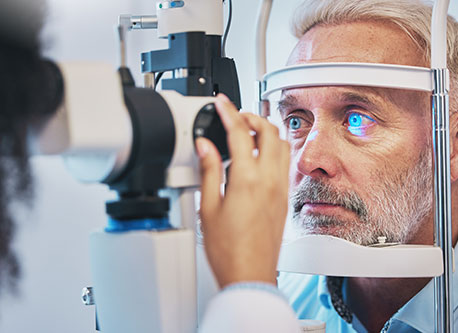What is Glaucoma?
published on: 14th march, 2023
Dr. Mohamed Ali El-Deeb is a Consultant Ophthalmologist who specializes in medical and surgical eye care including Glaucoma, Cataract and Strabismus surgeries and Oculoplasty. He won the Abu Dhabi Surgical Performance Award in 2011 and the grand price and top oral presentation award in the 5th International Congress on Glaucoma Surgery held in Delhi for the innovation of a new surgical technique in Glaucoma surgery called as Trabeculectomy with Deep Scleral Tunnel. He participated as an Instructor for Fundus Fluoresce in Angiography Instruction Course in the annual meetings of the Egyptian Ophthalmic Society in 1997 and 1998. He won the Professor Sabry KamiI Award of the Egyptian Society of Ophthalmology for the best published article in 1996.
What is Glaucoma?
Glaucoma refers to a group of diseases which have in common a characteristic pattern of optic nerve damage and visual field loss. Glaucoma is a progressive disease; and if left untreated may lead to complete and irreversible loss of vision.
In most of the cases of glaucoma, it is presumed that the pressure inside the eye is too high for the proper functioning of the optic nerve and that, lowering the eye pressure will stabilize the damage. The complexity of its management is related to the access to detection and treatment, stage of diagnosis, life expectancy and compliance with treatment as advised. It has been the focus of various studies due to the prevalence of anxiety and depression in glaucoma-diagnosed patients.
What are the types of Glaucoma?
Glaucoma is classified anatomically into:
- Open Angle Glaucoma - where the angle of the eye is open the anatomical site where the watery fluid inside the eye is drained.
- Closed Angle Glaucoma - where the angle of the eye is closed.
Glaucoma is classified etiologically according to the cause into:
- Primary Glaucoma - where there is no known ocular or systematic disease that causes increased intraocular pressure. Glaucoma is usually bilateral.
- Secondary Glaucoma - where there is known ocular or systematic disorder that causes increased intraocular pressure.
There is so many other classifications of Glaucoma. An important classification is the one which classifies glaucoma into Congenital and acquired. This because congenital glaucoma is a surgical condition, and the surgery has to be done as early as possible.
Who are at Risk of Developing Glaucoma?
- High internal eye pressure
- Being over the age of 60
- Family history of glaucoma
- Race: Patients of African origin are at higher risk of developing primary open angle glaucoma, while Inuits and East Asians are at higher risk of developing primary angle closure glaucoma.
- Patients with medical conditions such as diabetes.
- Thinning of the cornea in the center.
- Extreme near-sightedness/farsightedness
- Eye injury
- Certain types of medication such as corticosteroid eye drops.
References:
- Thylefors, B., & Negrel, A. D. (1994). The global impact of glaucoma. Bulletin of the World Health Organization, 72(3), 323.
- Qigley, H, A., & Broman, A. T. (2006). The number of people with glaucoma worldwide in 2010 and 2020. British journal of ophthalmology, 90(3), 262-267.
- Jng, K. I., Park, H. Y. L. & Park, C. K. (2021). The effect of anxiety and depression on progression of glaucoma. Scientific Reports, 11(1), 1-10.
- Chan, J. W., Chan, N., & Sadn, A. A. (2021). Glaucoma as Neurodegeneration in the Brain. Eye and brain, 13, 21-28. https://doi.org/10.2147/EB.S293765
Did You Know?
Glaucoma is painless and does not have acute attacks, thus the lack of clear symptoms make screening via regular eye check-ups important. The only signs are gradually progressive visual field loss and optic nerve changes (increased cup-to-disc ratio on fundoscopic examination).
recent posts
- Understanding Blepharitis: Causes, Symptoms, and Treatment Options
- The Role of Technology in Cataract Surgery: Abu Dhabi's Latest Techniques
- Understanding Keratoconus: Causes, Symptoms, and Diagnosis in Abu Dhabi
- Clearing the Fog: Understanding Glaucoma's Silent Threat to Vision
- Battling the Eye's Bumps: All You Need to Know About Pinguecula
- Understanding Pinguecula: Causes, Symptoms, and Management
- What Should I Consider When Choosing the Best Eye Hospital in Abu Dhabi?
- What is Diabetic Retinopathy?
- Diabetic Retinopathy
- Eye Squint (Strabismus)
- Keratoconus
- Cataract
- Dry Eyes Syndrome
- Chalazion
2024. All Rights Reserved Samaya Specialized Center
